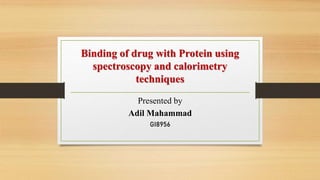
Protein-Ligand Interaction (1).pptx
- 1. Binding of drug with Protein using spectroscopy and calorimetry techniques Presented by Adil Mahammad GI8956
- 2. Content : What is protein? Amino acids Functions of proteins Structures of protein i. Primary structure ii. Secondary structure iii. Tertiary structure iv. Quaternary structure Protein-drug interaction Research plan Experimental techniques i. ITC ii. Fluorescence spectroscopy iii. CD spectroscopy Application of protein –drug interaction
- 3. What is protein ? The term “protein” was coined by Berzelius in1838. Proteins are organic compound with a high molecular weight formed of C, H, O, N and may also contain S, P , non-protein organic group and metal ions. Protein is a large and complex biomolecule consisted of amino acids linked together by peptide linkage. It is a macronutrient that is essential for building muscle mass and regulating all the body processes. They act as biological catalyst ( enzymes), forms structural part of organisms, participate in different cell reaction.
- 4. Amino acids : Amino acid in the form of protein is the second largest component of human muscle and other tissues. 20 Amino acids are naturally incorporated into polypeptides called proteinogenic or standard amino acids. These are divided into two types : • Essential amino acids: His, Ile, Leu, Met, Phe, Thr, Trp, Val, Lys. • Non-essential amino acids: Ala, Arg, Asn, Gln, Gly, Pro, Ser, Tyr, Cys, Glu, Asp.
- 5. 20% of human body is made up of proteins which are essential for structure, function, and regulation of the body tissues and organs. They perform various functions such as catalyzing metabolic reactions, DNA replication and transporting molecules from one location to another. Functions of Proteins
- 6. Structures of protein Primary structure Secondary structure Tertiary structure Quaternary structure
- 7. Primary structure : The linear sequence of amino acids in a polypeptide chain. Starting from the amino terminal (N) end to the carboxyl terminal (C) end. A change of just one amino acid in a protein’s sequence can affect the protein’s overall function and structure.
- 8. Secondary structure: H-bond between amino-hydrogen and carboxyl- oxygen atoms in the peptide backbone. α-Helix: The carbonyl of amino acid 1 form a H-bond to the N-H of amino acid 5. β-Sheet: Two or more polypeptide chain lineup next to each other, forming a sheet like structure held together by H-bonds.
- 9. Comparison of α-Helix and β-Sheet Criteria α-Helix β-Sheet Structure Coiled rod like Fully extended sheet like Axial distance between amino acids 1.5Å 3.5Å Number of constituent polypeptide chain One One or more polypeptide chain Stabilized by hydrogen bonds between NH and C=O groups in The same polypeptide chain Different or same polypeptide chain Hydrogen bonds are Parallel to polypeptide backbone Perpendicular to polypeptide backbone
- 10. Tertiary structure : single polypeptide chain “backbone” with one or more protein secondary structures. The formation of pockets and sites for the recognition and binding of ligands. Disulfide bonds contribute to tertiary structure most.
- 11. Quaternary structure: Highest classification level of protein structure. May be composed of two or more smaller protein chains. Multiple folded protein subunits in a multi- subunit complex. E.g : Hemoglobin, DNA polymerase and Antibodies etc.
- 12. Protein-drug Interaction: A protein-ligand binding is a spontaneous process which forms a complex of protein bound with ligand (where ligand means any molecule that binds with protein ). It is reversible non-covalent interaction (No sharing of electrons) between two molecules. This non-covalent binding may be influenced by these interactions: Electrostatic forces Van der Waals force hydrophobic interactions Solvent-related forces The binding of drug to plasma proteins is a major determinant of drug disposition. Drug-protein binding may be a reversible or an irreversible process.
- 13. How strong the binding is? (Affinity) What is the binding mechanism? Where it binds? (Binding site) How this binding change the conformation of protein? What are the thermodynamic profile for the complex formation? Which amino acids and what type of forces are responsible at the binding site? Research plan
- 14. Experimental Techniques System: Protein(macromolecule) with Drug(ligand) Spectroscopy: (a) Fluorescence (b) Circular dichroism Calorimetry: Isothermal titration calorimetry
- 15. Isothermal Titration Calorimetry 15 Fig: Isothermal titration calorimeter (MicroCal ITC200).
- 16. • Isothermal Titration Calorimetry of the Binding of drug to Protein at Different Temperatures Schematic diagram of ITC experiment The binding constant (Kb), binding stoichiometry (n), enthalpy change (∆Ho) and change in entropy (T∆So),Gibbs free energy (∆Go) have been directly obtained by using ITC experiment 16
- 17. Fluorescence spectroscopy Fig: Fluorescence spectrophotometer (Hitachi-2700).
- 18. Jablonski diagram of fluorescence
- 19. Circular Dichroism Spectroscopy 19 Fig: Circular dichroism spectroscopy (JASCO J-815).
- 20. CD spectroscopy determinines the structures and monitoring structural changes of biomolecules like proteins, carbohydrates and nucleic acids. Provide valuable information about the secondary structure content like α-helices, β-pleated sheets and β- turns.
- 21. Applications of protein-drug interaction : Protein-drug interaction is an important process in determining the activity, distribution, rate of excretion, and toxicity of drugs in the body. It is significant for the treatment of various diseases, providing safer and improved influence. It is vital to determine therapeutic effect of drugs during drug design and development. Level of free drug provide valuable information about the dose of drug. It is very important in understanding the pharmacokinetics and pharmacodynamics of drug which is useful for pharmaceutical industry.
- 22. THANK YOU